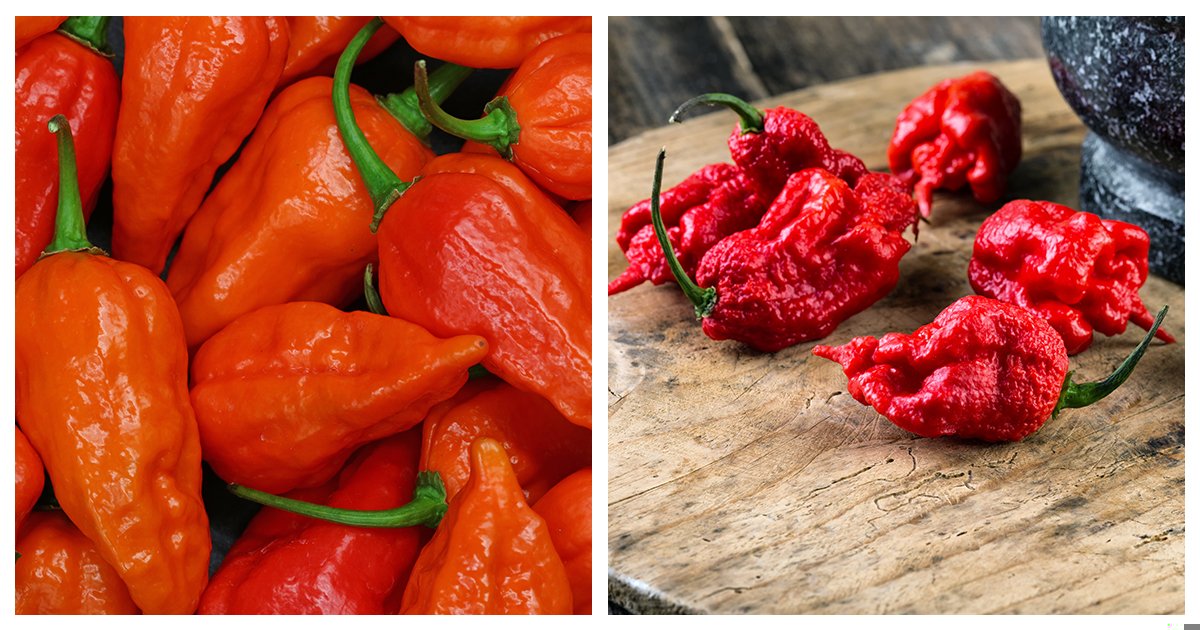When it comes to heat, the Carolina Reaper and the Ghost Pepper are two champions in the spicy pepper world. The Carolina Reaper holds the title for the hottest pepper, surpassing the Ghost Pepper by a significant margin.
Both peppers offer a unique flavor profile alongside their intense heat, making them popular in culinary challenges and hot sauce creations.
In the showdown of Carolina Reaper vs Ghost Pepper, the Reaper clearly takes the lead, but each pepper has its loyal fans. Whether you’re a thrill-seeker or a spice enthusiast, understanding these fiery contenders can elevate your culinary adventures.
Carolina Reaper vs Ghost Pepper
When it comes to fiery hot peppers, two names often come up in spicy conversation: the Carolina Reaper and the Ghost Pepper. Both of these peppers are among the hottest in the world, and they appeal to spice lovers and culinary adventurers alike.
In this article, we will dive deep into the world of these two formidable peppers. We’ll explore their origins, heat levels, flavor profiles, culinary uses, and even look at how they compare in different scenarios. Whether you’re a pepper enthusiast or just curious about spicy foods, this guide is for you!
Origins of the Carolina Reaper and Ghost Pepper
Understanding where these peppers come from adds an interesting layer to their stories.
Carolina Reaper
– The Carolina Reaper was bred by Ed Currie, who is the owner of the PuckerButt Pepper Company in South Carolina.
– It was created by cross-breeding a Pakistani Naga pepper and a Red Habanero.
– Officially recognized by the Guinness World Records in 2013 as the hottest pepper, the Carolina Reaper has an average heat level of around 1,641,183 Scoville Heat Units (SHU), with some individual peppers measuring over 2.2 million SHU.
Ghost Pepper
– The Ghost Pepper, known as Bhut Jolokia, hails from India, particularly the regions of Assam, Nagaland, and Manipur.
– This pepper gained international attention in the early 2000s and was certified as the world’s hottest pepper from 2007 until 2011.
– The Ghost Pepper has a heat level averaging around 1,041,427 SHU.
Heat Levels: The Scoville Scale Comparison
Heat is one of the primary reasons we discuss these peppers. To give you a clear idea of how they stack up, let’s take a look at their Scoville Heat Units.
Understanding Scoville Heat Units
The Scoville scale measures the heat of peppers based on the concentration of capsaicin, the chemical responsible for the spicy sensation. Here’s a quick breakdown:
– Mild peppers (like bell peppers): 0 SHU
– Jalapeño peppers: 2,500 to 8,000 SHU
– Habanero peppers: 100,000 to 350,000 SHU
– Ghost Pepper: Average around 1,041,427 SHU
– Carolina Reaper: Average around 1,641,183 SHU
Heat Comparison Table
| Pepper | Average SHU | Hottest Recorded SHU |
|———————|——————|———————–|
| Ghost Pepper | 1,041,427 SHU | 1,463,700 SHU |
| Carolina Reaper | 1,641,183 SHU | 2,200,000 SHU |
As we see from the table, the Carolina Reaper definitely takes the heat crown, but both peppers provide a level of spice that can challenge even the most seasoned spice lovers.
Flavor Profiles
While heat is a major consideration, flavor is equally important when cooking with these peppers. Let’s explore their unique flavor profiles.
Carolina Reaper Flavor
– The Carolina Reaper has a distinct fruity flavor, often described as sweet with hints of chocolate and cinnamon.
– Many people appreciate how the initial sweetness contrasts with the intense heat, making it a favorite in sauces and dishes where bold flavors are needed.
Ghost Pepper Flavor
– The Ghost Pepper offers a slightly smoky and earthy flavor, with a more straightforward heat that hits quickly.
– It has a somewhat fruity undertone as well, though it tends to be less sweet compared to the Carolina Reaper.
– The Ghost Pepper’s flavor can easily dominate a dish, so it’s often used sparingly.
Culinary Uses of Carolina Reaper and Ghost Pepper
Both of these peppers are popular in cooking, but they are used in different ways based on their flavor and heat profiles.
Carolina Reaper Culinary Applications
– **Hot Sauces**: The fruity profile of the Carolina Reaper lends itself well to hot sauces that aim for both heat and flavor.
– **Spicy Dishes**: Chefs use it in stews, curries, and marinades where a complex flavor is desired.
– **Garnishing**: Some brave souls chop it finely and use it as a garnish for various dishes.
Ghost Pepper Culinary Applications
– **Salsas**: The Ghost Pepper’s robust flavor pairs well in salsas, providing both heat and complexity.
– **Chili**: Many chili recipes incorporate Ghost Peppers to give them an extra kick.
– **Seasoning**: It can be used as a seasoning in spice blends for meats and roasted vegetables.
Health Benefits and Risks
Hot peppers, including the Carolina Reaper and Ghost Pepper, may offer health benefits. However, moderation is crucial.
Health Benefits
– **Rich in Vitamins**: Both peppers are high in Vitamin C and other antioxidants.
– **Pain Relief**: Capsaicin has been known to provide pain relief and may help in certain medical conditions.
– **Metabolism Boost**: The heat from peppers can increase metabolism, potentially aiding in weight loss.
Risks of Consuming Extremely Hot Peppers
– **Gastrointestinal Distress**: Eating very hot peppers can cause stomach pain, diarrhea, and nausea.
– **Burning Sensation**: Extreme heat can lead to discomfort or a burning sensation in the mouth and throat.
– **Allergic Reactions**: Some individuals may experience allergic reactions or sensitivities.
The Heat Challenge: Carolina Reaper vs Ghost Pepper
For those looking to test their spice tolerance, both peppers offer an exciting challenge. Here are some fun ways to engage with these peppers.
Tasting Challenge
– Organize a tasting challenge with friends to see who can handle the heat. Prepare small bites featuring both peppers.
– Make sure to include dairy products like milk or yogurt to help alleviate the heat for those who need it.
Cooking Competition
– Host a cooking competition where participants create dishes featuring either the Carolina Reaper or Ghost Pepper.
– Taste-test the entries and vote on the best flavor while considering the heat.
Growing Carolina Reaper and Ghost Pepper
For gardening enthusiasts, growing your own hot peppers can be rewarding.
Carolina Reaper Growing Tips
– **Climate**: Prefers warm climates, ideally between 70°F and 85°F.
– **Soil**: Requires well-draining soil rich in organic matter.
– **Watering**: Needs consistent moisture but avoid overwatering.
Ghost Pepper Growing Tips
– **Climate**: Thrives in hot climates, needing similar conditions to the Carolina Reaper.
– **Soil**: Grows best in fertile, well-drained soil.
– **Watering**: Keep soil moist but not soggy for best results.
Final Thoughts: Which Pepper Should You Choose?
Choosing between the Carolina Reaper and Ghost Pepper depends on what you seek. If you want maximum heat with a fruity flavor, reach for the Carolina Reaper. If you prefer a smoky, bold pepper with a robust kick, go for the Ghost Pepper.
Experimenting with both can diversify your culinary experience and help you discover which one suits your palate. Always remember to handle these peppers with care, using gloves if needed, and start with small amounts when cooking or tasting.
Whether you’re spicing up a dish or challenging friends to handle the heat, both peppers pack a powerful punch that can’t be ignored!
Carolina Reaper x Ghost Pepper Review
Frequently Asked Questions
What are the main differences in heat between Carolina Reaper and Ghost Pepper?
The Carolina Reaper is significantly hotter than the Ghost Pepper. The Carolina Reaper averages around 1.6 million Scoville Heat Units (SHU), with some individual peppers reaching over 2.2 million SHU. In contrast, the Ghost Pepper, also known as Bhut Jolokia, typically measures around 1 million SHU. This difference in heat intensity makes the Carolina Reaper one of the hottest peppers in the world.
How do the flavors of Carolina Reaper and Ghost Pepper compare?
The Carolina Reaper has a fruity, sweet flavor that includes hints of chocolate and a lingering burn, while the Ghost Pepper has a more earthy and smoky profile. Although both peppers pack a significant punch, many people find the Carolina Reaper’s flavor to be more complex and enjoyable in culinary applications compared to the Ghost Pepper’s more straightforward heat.
Can you use Carolina Reaper and Ghost Pepper interchangeably in recipes?
While you can substitute one for the other in recipes, it’s essential to adjust the quantity based on their heat levels. Use fewer Carolina Reapers than Ghost Peppers due to their higher heat concentration. Always taste and adjust to achieve the desired spice level without overwhelming the dish.
What are some common uses for Carolina Reaper and Ghost Pepper?
Both peppers are popular in hot sauces, spicy snacks, and as flavor enhancers in various dishes. The Carolina Reaper is often used in extreme heat challenges and competitive eating events. Ghost Peppers are frequently featured in Indian cuisine and can be included in chutneys and pickles for added spice.
How should you handle Carolina Reaper and Ghost Pepper safely?
When handling these extremely hot peppers, always wear gloves to prevent skin irritation and avoid touching your face, especially your eyes. Wash your hands thoroughly after handling them. Additionally, consider using a mask or working in a well-ventilated area when chopping or cooking with these peppers to minimize discomfort from the capsaicin vapors.
Final Thoughts
The Carolina Reaper and Ghost Pepper both stand out in the world of hot peppers. The Carolina Reaper, known for its extreme heat, averages around 1.6 million Scoville Heat Units (SHU), while the Ghost Pepper, or Bhut Jolokia, typically sits around 1 million SHU.
Both peppers have unique flavor profiles that appeal to chili enthusiasts. When comparing Carolina Reaper vs Ghost Pepper, the Reaper often takes the crown for heat, but the Ghost Pepper offers a distinct taste that many enjoy. Ultimately, both peppers serve as a thrilling challenge for those who seek intense spice experiences.






